
Visit an active commercial building site, and you may see EIFS insulating board being installed. If you see this, you will likely also observe foam pellets, or particulate fines, drifting in the air or scattered on the ground.
These foam pellets are generated by workers performing rasping activities on EIFS siding. As the rasping tool is worked across the surface of EIFS boards, the particles shaved off the surface free-fall to the ground. A slight breeze can cause EIFS fines to drift off-site, particularly with multi-story buildings.

THE ISSUE:
Uncontrolled particulate matter of this nature presents compliance risk across multiple environmental media.
- Stormwater: Discharge of foam particulate in stormwater is not permitted under EPA or state Construction General Permits (CGP). Discharge of this nature to stormwater sewers can impact the quality of receiving waters and are prohibited.
- Waste Management: The moment that these fines are generated, they are considered waste material. Open dumping onto land is prohibited by federal, state and local laws and regulations. Allowing particulate matter from rasping operations to accumulate off-site is considered improper disposal.
A situation like this could bring enforcement action from agency water quality and solid waste departments.
Styrofoam fines released from elevated work areas can be carried significant distances by wind. This presents additional risk exposure for project sites near sensitive environments, landmarks or public gathering places.
Complaints from affected parties could result in costs associated with clean-up, as well as damaged public perception. There is also a possibility for termination of building permits if issues persist.
SOLUTIONS:
Construction firms installing EIFS products can significantly reduce the impacts of rasping activities with a little planning and diligence. Solutions include:
- Enclosing scaffolding with netting to help contain Styrofoam fines and prevent transport via wind drift.
- Housekeeping measures, including periodic vacuuming of foam particles that fall to the ground or drift out of the containment netting.
- Inspections of nearby areas and housekeeping as needed to reduce off-site impact.
ADDITIONAL NOTES:
- Containing fines at the source of generation provide the best chance at managing the issue.
- Review any potential safety impacts prior to installing any form of containment netting on scaffolding. Some materials may catch wind and cause the scaffolding to become unstable.
- There are commercially available rasping tools with vacuum attachments available for use.
- An approach combining safe enclosure and diligent housekeeping should provide effective control and prevent deposition of fines in waterways, sewers and surrounding properties.

Need assistance with managing EIFS on an upcoming project, contact us.


